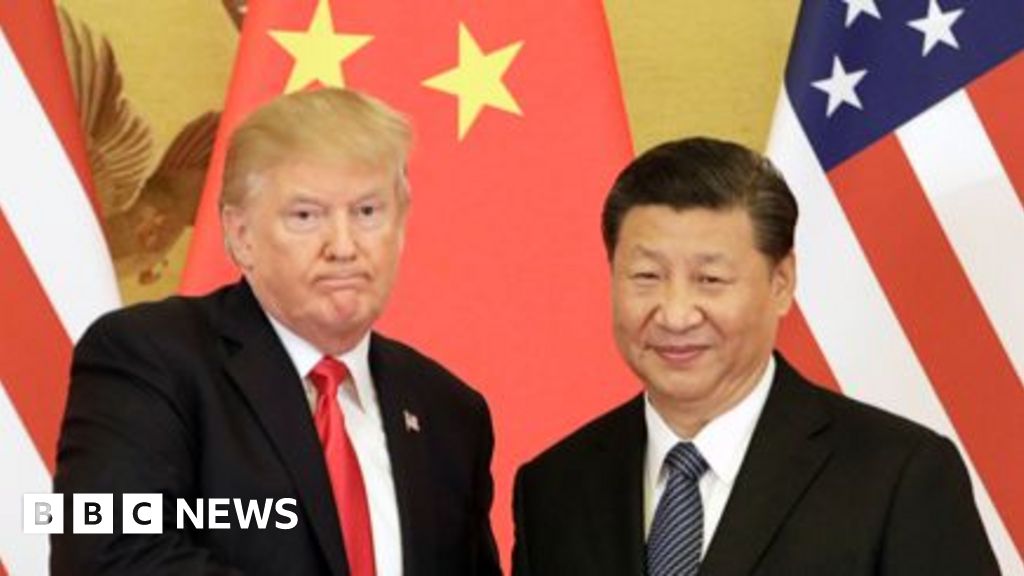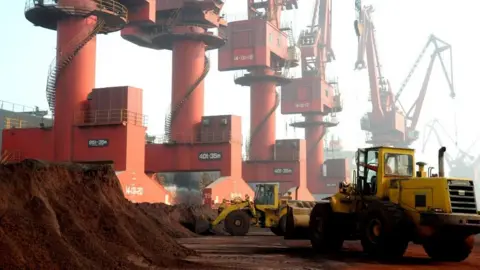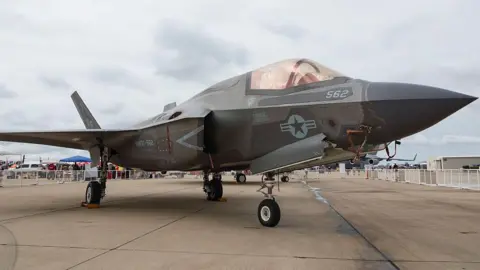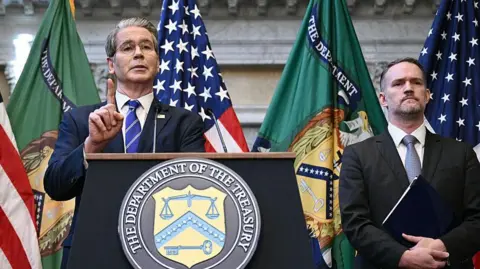Business
China has found Trump’s pain point – rare earths

Osmond ChiaBusiness reporter
 Reuters
ReutersLast week, China’s Ministry of Commerce published a document that went by the name of “announcement No. 62 of 2025”.
But this wasn’t just any bureaucratic missive. It has rocked the fragile tariffs truce with the US.
The announcement detailed sweeping new curbs on its rare earth exports, in a move that tightens Beijing’s grip on the global supply of the critical minerals – and reminded Donald Trump just how much leverage China holds in the trade war.
China has a near-monopoly in the processing of rare earths – crucial for the production of everything from smartphones to fighter jets.
Under the new rules, foreign companies now need the Chinese government’s approval to export products that contain even a tiny amount of rare earths and must declare their intended use.
In response, US President Donald Trump threatened to impose an additional 100% tariff on Chinese goods and put export controls on key software.
“This is China versus the world. They have pointed a bazooka at the supply chains and the industrial base of the entire free world, and we’re not going to have it,” said US Treasury Secretary Scott Bessent.
On Thursday, China said the US had “deliberately provoked unnecessary misunderstanding and panic” over the rare earths restrictions.
“Provided the export licence applications are compliant and intended for civilian use, they will be approved,” a commerce ministry spokesperson added.
This week, the world’s two biggest economies also imposed new port fees on each other’s ships.
The flare-up in the trade war brings to an end months of relative calm after top US and Chinese officials brokered a truce in May.
Later this month, Trump and China’s President Xi Jinping are expected to meet and experts have told the BBC the rare earths restrictions will give China the upper hand.
China’s new controls are bound to “shock the system” as they target vulnerabilities in American supply chains, said international business lecturer Naoise McDonagh from Australia’s Edith Cowan University.
“The timing has really upset the kind of timeline for negotiations that the Americans wanted,” he added.
 Getty Images
Getty ImagesRare earth minerals are essential for the production of a whole range of technology such as solar panels, electric cars and military equipment.
For example, a single F-35 fighter jet is estimated to need more than 400kg (881.8lb) of rare earths for its stealth coatings, motors, radars and other components.
China’s rare earth exports also account for around 70% of the world’s supply of metals used for magnets in electric vehicle motors, said Natasha Jha Bhaskar from advisory firm the Newland Global Group.
Beijing has worked hard to gain its dominance of the global rare earth processing capacity, said critical minerals researcher Marina Zhang from the University of Technology Sydney.
The country has nurtured a vast talent pool in the field, while its research and development network is years ahead of its competitors, she added.
While the US and other countries are investing heavily to develop alternatives to China for supplies of rare earths, they are still some way from achieving that goal.
With its own large deposits of rare earths, Australia has been tipped as a potential challenger to China. But its production infrastructure is still underdeveloped, making processing relatively expensive, Ms Zhang said.
“Even if the US and all its allies make processing rare earths a national project, I would say that it will take at least five years to catch up with China.”
The new restrictions expand measures Beijing announced in April that caused a global supply crunch, before a series of deals with Europe and the US eased the shortages.
The latest official figures from China show that exports of the critical minerals were down in September by more than 30% compared to a year ago.
But analysts say China’s economy is unlikely to be hurt by the drop in exports.
Rare earths make up a very small part of China’s $18.7tn a year economy, said Prof Sophia Kalantzakos from New York University.
Some estimates put the value of the exports at less than 0.1% of China’s annual gross domestic product (GDP).
While rare earths’ economic value to China may be tiny their strategic value “is huge”, she said, as they give Beijing more leverage in talks with the US.
Despite accusing China of “betrayal”, Bessent has left the door open to negotiations.
“I believe China is open to discussion and I am optimistic this can be de-escalated,” he said.
During a meeting with the US private equity group Blackstone’s chief executive Stephen Schwarzman on Thursday, China’s Foreign Minister Wang Yi also highlighted the need for talks.
“The two sides should engage in effective communication, properly resolve differences and promote stable, healthy and sustainable development of China-US relations,” Wang said, according to the ministry’s website.
What China has done recently is “getting its ducks in a row” ahead of those trade talks with the US, said Prof Kalantzakos.
In curbing rare earth exports, Beijing has found its “best immediate lever” to pressure Washington for a favourable deal, Ms Bhaskar said.
 Getty Images
Getty ImagesJiao Yang from Singapore Management University believes that although Beijing holds the cards in the short-run, Washington does have some strategic options at its disposal.
The US could offer to lower tariffs, which is likely to be attractive to Beijing as the trade war has hit its manufacturers hard, said Prof Jiao said.
China’s economy is reliant on the income from the goods it makes and exports. The latest official figures show its exports to the US were down by 27% compared to a year ago.
Washington can also threaten to hit China with more trade restrictions to hamper efforts to develop its technology sector, said Prof McDonagh.
For example, the White House has already targeted China’s need for high-end semiconductors by blocking its purchases of Nvidia’s most advanced chips.
But experts say that is likely to have only limited effects.
Measures targeting Beijing’s tech industry may slow China but won’t “stop it dead in the water,” said Prof McDonagh.
China has shown with its recent economic strategy that it is willing to take some pain to achieve its long-term goals, he added.
“China can carry on even if it costs a lot more under US export controls.
“But if China cuts off these rare earth supplies, that can actually stop everyone’s industry. That’s the big difference.”
Business
Credit Card Spends Ease In October As Point‑Of‑Sale Transactions Grow 22%

New Delhi: Credit card spending eased by Rs 2.5 billion in October to Rs 2,142 billion, a moderation of 1.1 per cent month‑on‑month but an increase of 6.1 per cent year‑on‑year, driven by a sharp shift toward point‑of‑sale transactions, a report said on Tuesday.
“The strong POS growth can likely be attributed to festive (Diwali) spending, whereas muted online spends are due to the elevated base of the previous month,” the report from Asit C. Mehta Investment Intermediates Limited said.
Point‑of‑sale transactions grew 22 per cent month‑on‑month and 11.4 per cent year‑on‑year, while online spending declined 12.7 per cent MoM and rose 2.7 per cent YoY. The top 10 banks accounted for 94 per cent of total spending, with HDFC Bank recording the highest MoM spending market share gain in October.
An increase of 6.7 per cent is seen in the total number of cards outstanding on a YoY basis, adding a total of 0.63 million cards, the report said. Transaction volumes saw a healthy growth of 4.6 per cent MoM and 19.2 per cent YoY. The YoY growth is lower than the historical average due to a high base last year.
Since volume growth outpaced spend growth, the average spend per transaction declined by 6 per cent MoM and 11 per cent YoY. With card issuance rising and overall spending remaining flat, the average spend per card declined 1.7 per cent MoM and 0.5 per cent YoY.
IndusInd Bank reported a steep 36 per cent MoM decline in average spend per card, due to a sharp fall of 34 per cent in its total spends. Among major banks, HDFC Bank led with 0.14 million new cards, followed by SBI (0.13mn), ICICI Bank (0.1mn), and Axis Bank (0.08mn). HDFC Bank reported the highest YoY gain of 1.12 per cent.
Business
Apartment rents drop further, with vacancies at record high

A version of this article first appeared in the CNBC Property Play newsletter with Diana Olick. Property Play covers new and evolving opportunities for the real estate investor, from individuals to venture capitalists, private equity funds, family offices, institutional investors and large public companies. Sign up to receive future editions, straight to your inbox.
A slew of new supply is still making its way through the multifamily housing market. That, coupled with weakening demand, especially from the youngest workers, is pushing vacancies up and rents down.
The national median rent for apartments fell 1% in November from October, and now stands at $1,367, according to Apartment List. It was the fourth consecutive month-over-month decline. Apartment rents are down 1.1% from November 2024 and have fallen 5.2% from their 2022 peak.
“Earlier this year, it appeared that annual growth was on track to flip positive for the first time since mid-2023; however, that rebound stalled out and reversed course during a particularly slow summer,” according to Apartment List researchers.
After hitting a record high for this index, which dates back to 2017, in October, the national multifamily vacancy rate remained at 7.2% in November.
The historic surge in multifamily construction over the past few years is now pulling back, but a good supply of new units is still coming online at a time of much weaker demand.
The fall historically sees the biggest slowdown in multifamily rents, but this year it’s even more pronounced. CoStar reported the biggest monthly drops in median rent it had seen in 15 years of tracking. The primary reason is that more young people are struggling to form new households.
“That 18- to 34-year-old group … I think it’s up to 32.5% of those now are living with family, and that’s the highest it’s been in a while,” said Grant Montgomery, CoStar’s national director of multifamily analytics. “I think it reflects high rental costs that have risen over the years, as well as the tougher job market for young folks just coming out of college.”
“That is where a lot of demand traditionally comes from, the core renter demand is from that sort of younger base,” he said.
The weakness is showing up in stocks of the major public apartment REITs. Names like AvalonBay, Equity Residential and Camden Property Trust are all down year to date.
Some markets are seeing rents drop faster than others, due to local economic factors. Las Vegas, for example, is experiencing slower tourism, which in turn hits jobs there. Boston has seen a decline in federal funding for biotech as well as a drop in foreign students for its colleges and universities; both are impacting its rental sector hard. Austin, Texas, is seeing the biggest hit to rents, thanks to still more construction of multifamily units.
While rents are softening nationally, and landlords are boosting concessions, renters are increasingly searching in more affordable markets.
Cincinnati was the market most searched for, followed by Atlanta and Kansas City, Missouri, according to a Yardi report that looked at where apartment hunters were active last summer, the traditionally busiest time for new leasing. St. Louis saw the biggest quarterly jump in tenant interest, and Washington, D.C., dropped from the top spot to No. 4.
“The Midwest, in particular, drew more attention than ever, signaling that many of its ‘hidden gem’ markets are no longer a secret,” according to the report, which found 11 of the top 30 cities for renter demand were in the Midwest.
Yardi also revised its expectations for 2026 supply, saying that while new supply will decline through 2027, a larger-than-expected under-construction pipeline caused it to increase its previous quarterly estimates for 2025 and 2026 by 6.8% and 2.5%, respectively.
As construction continues to slow into next year, the overall market should stabilize somewhat, according to the Apartment List report.
“That said, the supply boom still has a bit of runway remaining, and the demand outlook has begun to appear weaker amid a shaky labor market,” researchers wrote.
Business
India-Russia ties: Moscow signals readiness to fix trade deficit; energy, defence and new payment architecture on agenda – The Times of India

Russia on Tuesday said it is ready to address India’s concerns over the widening trade deficit and proposed building a framework to shield bilateral commerce from pressure by third countries. Kremlin spokesperson Dmitry Peskov, speaking ahead of President Vladimir Putin’s visit to New Delhi, said Moscow is also working to stabilise crude supplies after a brief dip linked to Western sanctions, according to PTI.Peskov told reporters during a video-streamed news conference that Friday’s summit between Putin and Prime Minister Narendra Modi will focus on strengthening trade, energy cooperation, small modular nuclear reactors and additional defence projects. Putin is scheduled to arrive on Thursday for the annual meeting.Russia signals efforts to ease trade deficitPeskov acknowledged India’s concern over the large trade gap and said Russia is keen to increase its imports from India. “There is a real imbalance in our trade. We know our Indian friends are concerned about that. We are jointly looking at the possibilities of increasing imports from India. We want to buy more from India,” he said.India’s purchases of Russian goods and services amount to around $ 65 billion, while Russia’s imports from India are around $ 5 billion.He also said Moscow is taking steps to ensure crude supplies remain stable despite the impact of Western restrictions. India’s purchase of Russian oil, he said, may dip only for a “very brief period.”Push for alternative payment systems and sanctions-proof tradePeskov urged the creation of an “architecture” to insulate India-Russia trade from geopolitical pressure. “We should create an architecture of our relationship that must be free of any influence coming from any third country,” he said. He stressed that bilateral trade must be protected from external pressure and that Russia rejects the use of the dollar-denominated global payment system as a “political tool.”He indicated that settlement through national currencies may feature in the Modi-Putin talks. “We understand the pressure on India,” he said, referring to the US.The visit comes at a tense moment in India-US ties, with Washington imposing a 50% tariff on Indian goods and an additional 25% levy linked to New Delhi’s procurement of Russian crude.Defence, nuclear cooperation and technology sharingPeskov highlighted joint production of the BrahMos missile system as a model for high-technology collaboration and said discussions may cover potential supplies of Su-57 fighter jets and additional S-400 air defence systems. He also said cooperation in small and medium nuclear reactors is expected to be part of the talks. Russia has experience producing these systems and is prepared to share the technology with India.On China, Peskov said Russia’s “limitless” partnership with Beijing does not diminish its willingness to deepen ties with India. “We are ready to go as far as India is ready,” he said, adding that Moscow respects India-China relations and hopes both sides resolve their issues to preserve global stability.Ukraine conflict, counter-terrorism and Afghanistan tiesPeskov welcomed recent US mediation efforts in the Ukraine conflict, calling them “very effective” and expressing hope for progress. He said the Russia-Ukraine war will be an important part of the Modi-Putin agenda. “Russia is open for peaceful negotiation; we have to reach our goals. We appreciate the position of India,” he said.He added that Russia is ready to work with India “to combat terrorism,” and said Moscow is strengthening its engagement with Afghanistan. “We’ll continue to develop our relationship with Afghanistan,” he noted.On overall ties, Peskov said Russia is proud to stand “shoulder-to-shoulder” with India during its period of historic growth.
-

 Sports1 week ago
Sports1 week agoWATCH: Ronaldo scores spectacular bicycle kick
-

 Entertainment1 week ago
Entertainment1 week agoWelcome to Derry’ episode 5 delivers shocking twist
-

 Politics1 week ago
Politics1 week agoWashington and Kyiv Stress Any Peace Deal Must Fully Respect Ukraine’s Sovereignty
-

 Business1 week ago
Business1 week agoKey economic data and trends that will shape Rachel Reeves’ Budget
-

 Tech2 days ago
Tech2 days agoGet Your Steps In From Your Home Office With This Walking Pad—On Sale This Week
-

 Tech1 week ago
Tech1 week agoWake Up—the Best Black Friday Mattress Sales Are Here
-

 Politics1 week ago
Politics1 week ago53,000 Sikhs vote in Ottawa Khalistan Referendum amid Carney-Modi trade talks scrutiny
-

 Sports2 days ago
Sports2 days agoIndia Triumphs Over South Africa in First ODI Thanks to Kohli’s Heroics – SUCH TV







